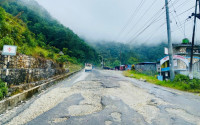Gandaki Province
Deaths of vultures by electrocution go unchecked in Tanahun
Around 100 vultures have died of electrocution at Shishuwa Bateri in Byas Municipality in the past two years.
Samjhana Rasaili
At a time when government authorities and conservationists are concerned about vulture conservation in the country, deaths of vultures caused by electrocution are going unchecked at Shishuwa Bhateri in Byas Municipality-10, Tanahun.
Three vultures were electrocuted while another was injured on Monday while they attempted to perch on an electricity pole of the Bhorletar-Damauli 33 KV transmission line of Midim Hydropower Project.
"Two vultures were lying dead below the transmission line while another was found hanging from the electricity pole. And the fourth one was found injured. The transmission line, as it was set up without studying its sustainability impact, has become a death trap for the endangered vulture," said Ram Prasad Sapkota, a resident of Byas-10.
Several species of vultures have been spotted in the area after Byas Municipality set up a Cow Conservation Centre, locally known as Gaushala, on the banks of the Madi river four years ago to manage stray quadruped animals. Old and diseased cows and other animals die often and the vultures visit the area to eat the carcasses.
According to Prajapati Sapkota, the chairman of the Gaushala, around 500 vultures of different species circle the area when two to three cows die in a single day. After eating the carcasses, the vultures generally search for high places to rest.
“In doing so the vultures get electrocuted," said Prajapati, stating that around 100 vultures have died of electrocution in the area in the past two years.
"We were very happy as many vultures were spotted in the area after the Gaushala was established. But it is disheartening to see this area turn into a death trap for the vultures. Not only the vultures but human beings are also at risk of the transmission line," he complained.
The municipality had set up the Cow Conservation Centre, as the stray cattle caused road accidents and damaged crops. Currently, there are 102 cows, mainly old and diseased, in the centre. Along with the management of stray animals, the Gaushala plays an important role in conserving the vulture population in the area.
However, the stakeholders have expressed their concerns that the electricity transmission line is endangering the vulture population that has been flocking to the area after the Gaushala’s establishment.
"The Gaushala helps manage stray cows and resolve the problem of road accidents and crop damage. It also helps conserve vulture populations that feed on dead animals and clean the environment naturally,” said Man Bahadur Darai, another local resident. “But the vultures are dying of electrocution on a regular basis and the authorities seem indifferent to the issue.”
On the other hand, Tulsiram Sapkota, the ward chairman of Byas-10, says the local unit is equally concerned about the conservation of the vultures.
“We have informed the Midim Hydropower Project and the Tanahun distribution centre of Nepal Electricity Authority about the high number of vulture deaths caused by electrocution and asked them to address the problem. They said they would use high-quality insulated wires on electricity poles but nothing has been done yet," said Sapkota.
“The municipality plans to set up a protected area for vultures for their conservation. We also wrote a letter to the Division Forest Office in Tanahun to impose a ban on cutting down Simal (kapok) trees in the area as the vultures need tall trees to stay and nest," he said.
According to ornithologists, nine vulture species have been recorded in Nepal. The white-rumped vulture, slender-billed vulture, red-headed vulture and Indian vulture are listed as critically endangered; the Egyptian vulture is listed as endangered while three other vulture species—bearded vulture, cinereous vulture and Himalayan griffon—are listed as near threatened.




 10.12°C Kathmandu
10.12°C Kathmandu










